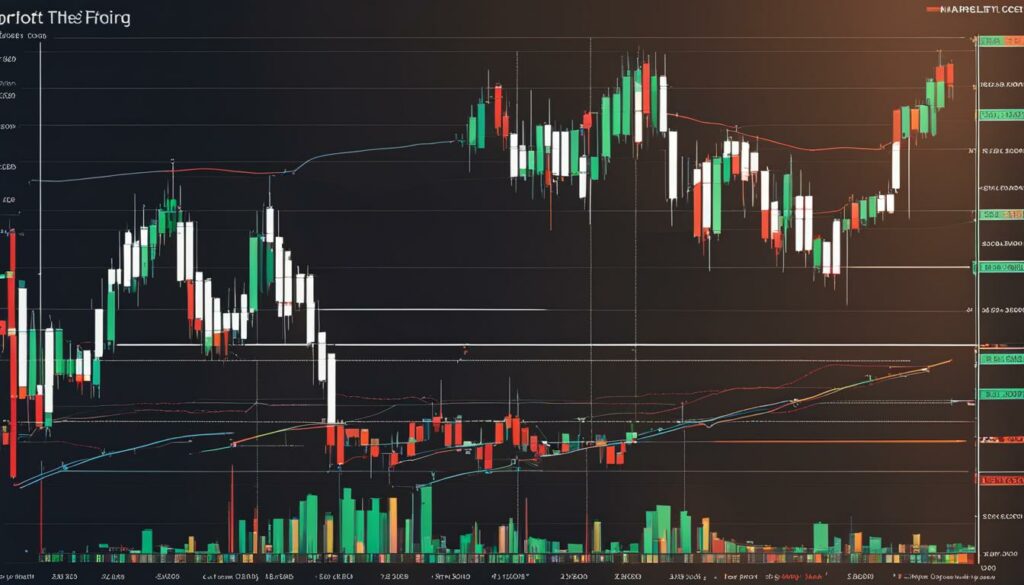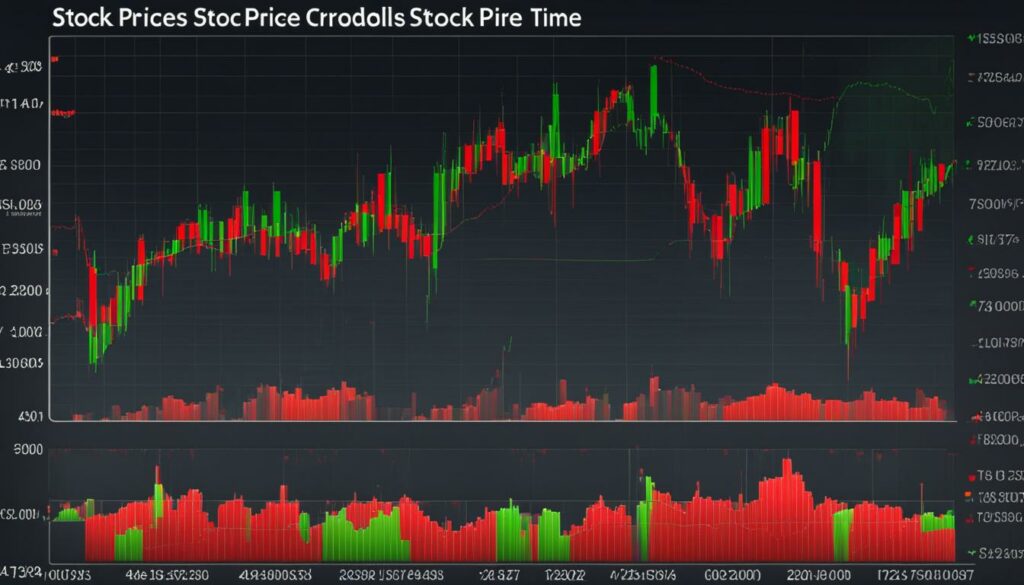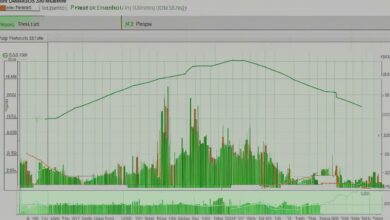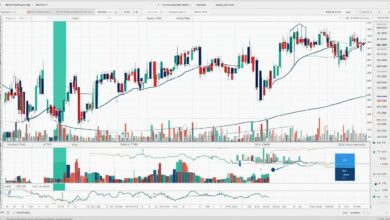Selling Both Puts And Calls: Profitable Short Straddle Options Strategies

Welcome to our article on short straddle options strategies. In this guide, we will explore how selling both puts and calls can be a profitable approach for traders. A short straddle involves selling a call option and a put option with the same strike price and expiration date. This strategy is typically used when there is an expectation of minimal movement in the underlying asset. However, it is important to note that the short straddle strategy comes with unlimited risk, making it more suitable for experienced traders.
Key Takeaways:
- A short straddle involves selling both a call option and a put option with the same strike price and expiration date.
- Traders implement this strategy when they expect minimal movement in the underlying asset.
- The short straddle strategy carries unlimited risk and is more suitable for advanced traders.
- It is important to calculate the break-even point and understand the impact of time decay, volatility changes, and underlying price movement when employing a short straddle strategy.
- Early assignment is a risk associated with short straddle options strategies and should be managed effectively.
Components of a Short Straddle
A short straddle strategy consists of two main components: selling a call option and selling a put option with the same strike price and expiration date. This strategy is implemented when traders anticipate limited price movement in the underlying asset. Let’s explore each component in detail:
- Selling a call option: By selling a call option, traders assume the obligation to sell the underlying asset at the strike price if the option is exercised. They receive a premium in exchange for taking on this obligation.
- Selling a put option: When selling a put option, traders agree to buy the underlying asset at the strike price if the option is exercised. Once again, they receive a premium for assuming this obligation.
It’s important to note that both the call and put options in a short straddle strategy should have the same strike price and expiration date. This equilibrium helps traders maximize the profit potential of this strategy when the underlying asset maintains limited price movement.
When to Implement Short Straddle Strategies
Traders choose to implement short straddle strategies when they believe the underlying asset will experience minimal price fluctuations. This strategy is particularly effective in stable, range-bound market conditions. By selling both a call and put option, traders can benefit from the passage of time, as the value of these options erodes due to time decay.
However, it’s important to consider market factors such as implied volatility. Changes in implied volatility can affect the profitability of a short straddle strategy. Traders should monitor volatility levels and choose to implement this strategy when implied volatility is relatively low.
| Advantages | Disadvantages |
|---|---|
|
|
By understanding the components of a short straddle and carefully assessing market conditions, traders can strategically implement this options strategy to potentially generate profits.
Determining the Break-Even Point
When implementing a short straddle options strategy, it is crucial to determine the break-even point. This point is where the strategy neither makes a profit nor incurs a loss. To calculate the break-even point, we need to consider the total premium collected from selling both the call and put options.
The break-even point for a short straddle is determined by adding or subtracting the total premium collected from the strike price. For example, if the strike price is $50 and the total premium collected is $5, the break-even range would be between $55 and $45. In this range, the strategy would neither generate a profit nor a loss upon expiration.
Calculating the break-even point is essential because it helps us assess the potential profitability of the short straddle strategy. If the underlying asset’s price remains within the break-even range at expiration, the strategy can be profitable. However, if the price surpasses the break-even points, losses may occur.
| Strike Price | Total Premium Collected | Break-Even Range |
|---|---|---|
| $50 | $5 | $55 – $45 |
By calculating the break-even point, we can make informed decisions about whether to implement a short straddle strategy. It helps us understand the potential risks and rewards associated with this options strategy. Traders should carefully consider the break-even point and monitor the underlying asset’s price movements to manage their positions effectively.
Impact of Time Decay on Short Straddle
When implementing a short straddle options strategy, it’s essential to understand the impact of time decay, also known as theta. Time decay refers to the gradual reduction in the value of options as time passes. For a short straddle, this can be advantageous for the trader, as both the call and put options will decrease in value over time.
As the options approach their expiration date, the rate of time decay accelerates. This means that other things being equal, the short straddle strategy becomes more profitable as the expiration date approaches. However, it is important to note that time decay is not a guarantee of profit. The underlying asset’s price movement and changes in implied volatility can still impact the overall performance of the strategy.
“Time decay is our ally in a short straddle options strategy. As the options lose value over time, we can potentially generate profit without the need for significant price movement in the underlying asset.”
Traders should regularly monitor the time decay of their options positions and assess the impact it has on the profitability of their short straddle strategy. It is crucial to have a thorough understanding of the dynamics of time decay and how it interacts with other factors, such as volatility and underlying price movement, to make informed decisions.
Key points:
- Time decay refers to the gradual reduction in the value of options as time passes.
- For a short straddle strategy, time decay can be beneficial as both the call and put options decrease in value over time.
- The rate of time decay accelerates as the options approach their expiration date.
- Traders should regularly monitor the time decay of their options positions and consider its impact on the overall profitability of their short straddle strategy.

Role of Volatility Changes in Short Straddle
In a short straddle strategy, the role of volatility changes is crucial in determining the potential profitability of the trade. Volatility refers to the magnitude of price fluctuations in the underlying asset. When volatility decreases, it has a positive impact on the short straddle strategy, resulting in potential profits for the trader.
When implied volatility decreases, the value of both the call and put options in the short straddle position decreases as well. This decline in option value allows the trader to buy back the options at a lower price, generating a profit. It is important for traders using this strategy to closely monitor changes in implied volatility and consider them when entering or adjusting their short straddle positions.
“A decrease in implied volatility can lead to profits for short straddle traders as the value of the options decrease.”
On the other hand, an increase in implied volatility can have a negative impact on the short straddle strategy. When implied volatility increases, the value of both the call and put options in the short straddle position increases as well. This rise in option value can result in potential losses for the trader. It is therefore important for traders to be aware of and manage the risks associated with changes in volatility.
Impact of Volatility on Short Straddle Profitability
Volatility plays a significant role in determining the profitability of a short straddle strategy. Traders implementing this strategy should aim to enter positions when implied volatility is relatively high and then look for a decrease in volatility as the options approach expiration. This allows them to benefit from the decrease in option value and potentially realize a profit.
| Volatility | Impact on Short Straddle Profitability |
|---|---|
| Decrease | Potential for Profit |
| Increase | Potential for Loss |
By understanding and carefully considering the role of volatility changes, traders can make more informed decisions when implementing a short straddle strategy. Managing risk and monitoring implied volatility are essential aspects of successful options trading.
Impact of Underlying Price Change on Short Straddle
One of the key factors that can significantly impact the profitability of a short straddle strategy is the change in the underlying asset’s price. As a short straddle involves selling both a call and put option with the same strike price, any substantial movement in the price of the underlying asset can result in potential losses for the trader.
When the price of the underlying asset increases, the short call option loses value. This is because as the price rises above the strike price, the likelihood of the option being exercised by the buyer also increases. As a result, the trader may experience losses on the short call option. Conversely, when the price of the underlying asset decreases, the short put option loses value. This is because as the price falls below the strike price, the probability of the option being exercised by the buyer also increases, leading to potential losses on the short put option.
Therefore, it is crucial for traders implementing a short straddle strategy to closely monitor the price movements of the underlying asset. By keeping a close eye on the price and being prepared to manage potential losses, traders can make informed decisions and mitigate risks associated with changes in the underlying price.

Risks of Early Assignment
When trading short straddle options strategies, one of the key risks to consider is early assignment. Early assignment occurs when the options contracts are exercised by the counterparty before the expiration date. This can result in unexpected stock positions and significant losses if not properly managed.
Traders should be aware that when a short call option is assigned, they will be obligated to sell the underlying stock at the strike price. On the other hand, if a short put option is assigned, they will be obligated to buy the stock at the strike price. These obligations can lead to unfavorable outcomes, especially if the stock price moves significantly against the trader’s position.
To mitigate the risk of early assignment, traders can take certain precautions. One approach is to close out the short straddle position before the options’ expiration date. By doing so, traders can avoid the possibility of assignment altogether. Another strategy is to monitor the options closely and be prepared to take action if early assignment becomes likely. This may involve adjusting the position or closing it out entirely to limit potential losses.
It’s important to note that the risk of early assignment is not inherent to the short straddle strategy itself, but rather a potential outcome that traders should be aware of and manage accordingly. By understanding and actively addressing this risk, traders can navigate the complexities of the options market with greater confidence and control.

Calculating Maximum Profit and Assessing Maximum Risk
When implementing a short straddle strategy, it is crucial to calculate the maximum profit and assess the maximum risk associated with the trade. The maximum profit for a short straddle is the total premium collected when selling both the call and put options. This profit is realized if the options expire worthless. The formula for calculating the maximum profit is:
Maximum Profit = Total Premium collected
However, it is important to note that the potential risk of a short straddle strategy is unlimited. This is because the stock price can move significantly in either direction, resulting in large losses for the trader. To assess the maximum risk, traders should consider the worst-case scenarios and potential outcomes of the trade.
By carefully analyzing the potential profit and risk, traders can make informed decisions when executing a short straddle strategy. It is essential to have a thorough understanding of the strategy and its associated risks before entering into the trade. Risk management and position sizing are also vital aspects to consider when implementing a short straddle strategy.
| Components | Calculation |
|---|---|
| Total Premium collected | (Premium of short call option) + (Premium of short put option) |
| Maximum Profit | Total Premium collected |
| Maximum Risk | Unlimited |
Understanding the maximum profit and risk of a short straddle strategy is crucial for successful options trading. Traders should conduct thorough analysis and evaluate the potential outcomes of the trade before executing it. By having a clear understanding of these factors, traders can make informed decisions and effectively manage their risk.

Market Conditions for Short Straddle Strategies
Implementing a short straddle options strategy requires careful consideration of the market conditions. This strategy is most profitable in environments with low volatility and minimal price movement in the underlying asset. Stable, range-bound markets provide the ideal conditions for maximizing the potential profitability of a short straddle.
When market volatility is low, the value of both the call and put options in a short straddle will decrease. This decrease in implied volatility can result in a profit for the trader. However, it’s crucial to monitor changes in volatility closely as an increase in implied volatility can lead to losses.
In addition to volatility, traders should look for minimal price movement in the underlying asset. The short straddle strategy relies on the stock price staying within a certain range at expiration. In range-bound markets, where the price remains relatively stable, this strategy has a higher probability of success.
Example of Market Conditions for Short Straddle
“In a low volatility market with minimal price movement, a short straddle options strategy can be highly profitable. Traders can capitalize on the decreasing value of both the call and put options, generating a profit. However, it’s important to always monitor changes in volatility and be prepared to manage potential losses.”
By carefully assessing market conditions and considering factors such as volatility and price movement, traders can determine the ideal time to implement a short straddle strategy. Remember that this strategy comes with risks, including unlimited loss potential and the risk of early assignment, so it’s essential to have a thorough understanding of the market before executing the trade.

Example of a Short Straddle Strategy
In this section, we will illustrate an example of a short straddle strategy to provide a practical understanding of how this options strategy works. Let’s consider a scenario where a trader sells both a call and put option with a strike price of $25 for an underlying stock currently trading near $25 per share.
Now, suppose the stock price jumps to $50. In this case, the trader would be obligated to sell the stock for $25, resulting in a loss. If the trader does not own the stock, they would need to buy it at $50 in order to fulfill the obligation and then sell it at a loss for $25.
Calculating the breakeven points is crucial in implementing a short straddle strategy. In this example, the breakeven points would be $25 minus the total premium collected and $25 plus the total premium collected. These breakeven points represent the range at which the trader would start to incur losses or profits depending on the stock price movement.
| Stock Price | Profit/Loss |
|---|---|
| Below Breakeven Point (Less than $25 – Total Premium Collected) | Loss |
| Between Breakeven Points ($25 – Total Premium Collected to $25 + Total Premium Collected) | Profit |
| Above Breakeven Point (More than $25 + Total Premium Collected) | Loss |
It is important for traders to carefully analyze potential outcomes and risks associated with this strategy before implementing it. While short straddle strategies can be profitable in certain market conditions, they also come with the risk of unlimited loss potential and the possibility of early assignment. Traders should have a thorough understanding of this strategy and develop a plan to manage these risks effectively.
With this example and a clear understanding of the components, risks, and market conditions, traders can make informed decisions when considering a short straddle strategy as part of their options trading arsenal.

Conclusion
In conclusion, a short straddle options strategy can be a profitable approach for advanced traders when certain conditions are met. This strategy is most effective when implemented in market conditions with minimal price movement and decreased implied volatility. By selling both a call and put option with the same strike price and expiration date, traders can generate income from the premiums collected.
However, it is important to consider the risks associated with a short straddle strategy. The potential for unlimited losses exists, as the stock price can move significantly in either direction. Additionally, the risk of early assignment can lead to unexpected stock positions and substantial losses if not properly managed.
For example, let’s consider a short straddle strategy with a strike price of $25 for an underlying stock trading near $25 per share. If the stock price jumps to $50, the trader would be obligated to sell the stock at $25, resulting in a loss. Understanding the breakeven points and potential outcomes is crucial in executing this strategy.
Overall, it is essential for traders to thoroughly understand the short straddle options strategy and assess the potential profitability and risks before implementing it into their options trading. By carefully considering the market conditions, calculating maximum profit and risk, and monitoring factors such as implied volatility and underlying price movement, traders can make informed decisions and improve their chances of success.
FAQ
What is a short straddle strategy?
A short straddle is an options strategy where both a call option and a put option with the same strike price and expiration date are sold. It is used when the trader expects the underlying asset to have minimal movement.
When should I implement a short straddle strategy?
Traders implement a short straddle strategy when they believe the underlying asset will have limited price movement.
How do I determine the break-even point for a short straddle?
The break-even point for a short straddle is determined by adding or subtracting the total premium collected from the strike price. This range must be within the underlying asset’s price at expiration for the strategy to be profitable.
How does time decay impact a short straddle strategy?
Time decay, also known as theta, is beneficial for a short straddle strategy. As time passes, the value of both the call and put options decreases, generating profit for the trader.
What is the role of volatility changes in a short straddle strategy?
Changes in implied volatility can impact a short straddle strategy. Decreases in implied volatility lead to a decrease in the value of both the call and put options, resulting in a profit for the trader. Increases in implied volatility can lead to losses.
How does the underlying price change impact a short straddle strategy?
If the underlying asset’s price moves significantly in either direction, it can result in losses for a short straddle strategy. The short call option loses value as the price increases, while the short put option loses value as the price decreases.
What are the risks of early assignment in a short straddle strategy?
Early assignment is a risk associated with short straddle options strategies. Traders can be obligated to fulfill the obligation of selling or buying the stock at the strike price if the options are assigned before expiration. This can result in unexpected stock positions and significant losses if not managed properly.
How do I calculate the maximum profit and assess the maximum risk in a short straddle strategy?
The maximum profit for a short straddle strategy is the total premium collected when selling both the call and put options. However, the potential risk is unlimited, as the stock price can move significantly in either direction. Traders should carefully calculate and assess the maximum profit and risk before executing the trade.
What market conditions are ideal for implementing a short straddle options strategy?
Short straddle strategies are best implemented in market conditions with low volatility. When there is minimal price movement in the underlying asset, this strategy has a higher probability of success.
Can you provide an example of a short straddle strategy?
An example of a short straddle strategy involves selling both a call and put option with a strike price of $25 for an underlying stock trading near $25 per share. If the stock price jumps to $50, the trader would be obligated to sell the stock for $25. If they don’t own the stock, they would need to buy it at $50 and sell it for a loss. Calculating the break-even points and understanding potential outcomes is crucial in implementing this strategy.







